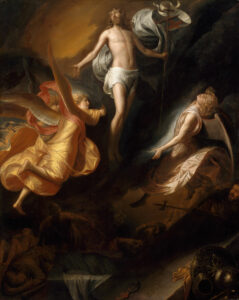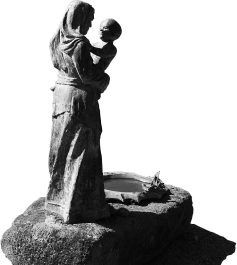Paschal Vigil
On this holy night on which Holy Mother Church gives us such a rich and diverse selection of sacred texts and holy rituals, it would be easy to miss seeing the forest for the trees. To be true, the liturgy of this night is so grandiose that for those who are not familiar with it, it’s usually one or another of its aspects that strikes us most. For example, many people are stunned by the beauty of the Exsultet and the blessing of the Paschal Candle. Others are fascinated by the solemn blessing of the baptismal font (and baptisms, if there are any) and the solemn prostration during the Litany of the Saints. As you get a bit older, you come to realise that, although those ceremonies remain breathtaking, the entire vigil is really about listening to God’s word. The ancient Roman Liturgy gives us no less than twelve long prophecies, texts taken from the Old Testament, each of which throws particular light on one aspect of the faith and prepares for the Gospel, which is the climax of all the readings.
It is, however, only a long frequentation of the sacred mysteries that leads one to see the inspiration behind it. These texts are not taken haphazardly from the Bible; the lucernarium ceremony at the beginning and the baptism of neophytes are not tucked away in this holy night just because we had to put them somewhere. If some of humanity’s greatest writers – a Dante or a Shakespeare or a Dickens –and its greatest artists and musicians – a Michelangelo, a Mozart, a Bach – gave us productions that even the most gifted of students can spend a lifetime exploring without ever fully exhausting all its riches, what are we to say of this climax of the Roman Liturgy? Is it conceivable that it could have been thrown together by a group of liturgical geeks who each had their own little idea about how liturgy should be – which sadly is what happened in the mid-twentieth century? No, the Holy Spirit Himself is behind this magnificent edifice, but as with every work of art and especially the work of the supreme artist, God, we should not be surprised that it takes us a lifetime to start to see all the pieces come together.
What is it all about? Like a symphony, it is very complex, but it all begins and ends with one very simple idea. That simple idea is this: All comes from God, and all returns to God, and whatever happens, even the bad things, is woven by God into the mystery of our salvation. This thought alone allows one to unite all the various parts of tonight’s liturgy into one magnificent mosaic.
From the dawn of time when God created the heavens and the earth, and then we fell and were nearly destroyed by the Flood, through Abraham and the call of the Hebrews to be the People of God, their long fidelity to God that gave us all the prophets, all of whom in various ways announced what was to come, admonishing sinners to return to God and hope in the future Redeemer who would open up salvation to all nations, and finally culminating in the supreme gift of the Messiah, the Son of God come in the flesh, crucified for us all. All this was but the preparation for what God had in mind all along. It was not an afterthought. He knew what He would do. But still, it takes our slow minds a lifetime to figure it out and accept the Resurrection in the flesh of His Son, Our Lord Jesus Christ, and the grafting of all those who believe in His death and resurrection through the sacraments of the faith.

This is the thread that goes through all our readings and unites them all. In the same way, every single one of the magnificent melodies we monks have sung throughout this past week is all woven into this Divine Comedy – to borrow the expression of the incomparable Dante – comedy, of course, being understood in the ancient sense of a story with a happy ending. Indeed, that is what is the most consoling aspect of this night, of the Church and all she has to offer, the underlying thought that changes our perspective on life and fills anyone who has come to understand it with a joy that can only explode in the most exuberant enthusiasm: we are not the product of blind evolution doomed to absurdity and despair; no, that is the conclusion reached by the person who simply does not reflect and ponder, and therefore fails to understand. The reality is that all is in God’s hands, He knew why He created us, He knew why He allowed us to sin, Heknew that by sending His Son to redeem us, He was elevating us to a much higher level than if we had not sinned (mirabiliter condidisti et mirabilius reformasti!), and He wants each and every one of us to find life, eternal life in His only-begotten Son, who – amazingly! – has become one of us. He stands on our side and accompanies us throughout each moment of our lives, prodding us on with His inspirations of grace, lifting us up when we fall, and often carrying us when we cannot even walk, and who will lead each of us through the gates of death, because He Himself passed those gates, and out of the grave, for He has broken the bonds of death and smashed the power of hell. One day, He will raise us up, just as He rises on this holy night, but it will not be to die again; rather, it will be to live forever and ever before His face.
Such is the overflowing joy that erupts in our hearts on this night and that overcomes all darkness and sadness that humans have ever known. This it is, and this alone, which makes it possible to, in the words of the Exultet, humble all pride, drive away all hatred, achieve peace, unity and concord among those who were heretofore divided by sin. This night, and throughout these holy days of paschal tide, there is no place for sadness or complaint. Let us all put aside any grievances and entrust them all to the Sacred Heart of the Risen Saviour, who holds us all in His hand and wants to conquer all evil in us and in others. On behalf of all the brethren of our community, this is the joy I wish each of you to experience tonight, tomorrow and always.
As a fitting conclusion to our Scriptural journey, let’s listen to what St John tells us of His vision of the Risen Christ in the last book of the Bible, the Apocalypse:
I was in the Spirit on the Lord’s day, and I heard behind me a loud voice… Then I turned to see the voice that was speaking to me, and on turning I saw seven golden lampstands, and in the midst of the lampstands one like a Son of Man, clothed with a long robe and with a golden sash around his chest. The hairs of his head were white, like white wool, like snow. His eyes were like a flame of fire, his feet were like burnished bronze, refined in a furnace, and his voice was like the roar of many waters. In his right hand he held seven stars, from his mouth came a sharp two-edged sword, and his face was like the sun shining in full strength. When I saw him, I fell at his feet as though dead. But he laid his right hand on me, saying, “Fear not, I am the first and the last, and the living one. I was dead, and behold I am alive forevermore, and I have the keys of Death and Hell” (Apocalypse 1:10-18).


